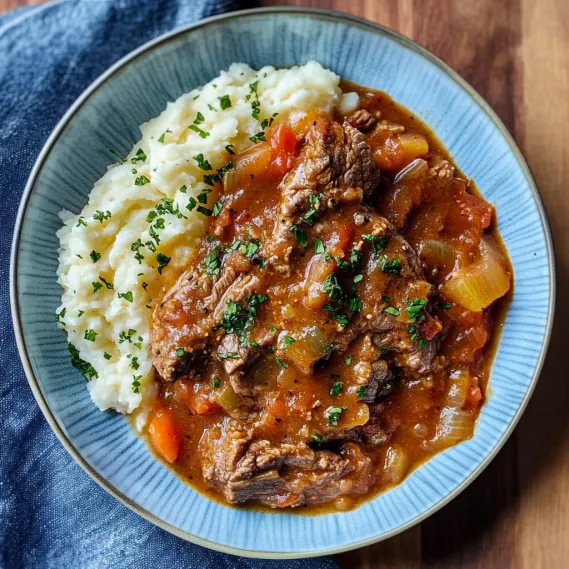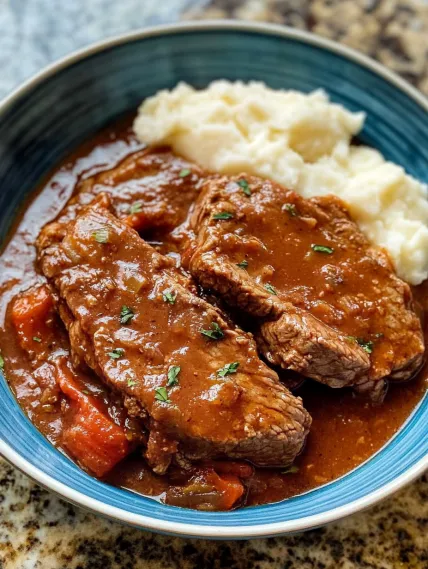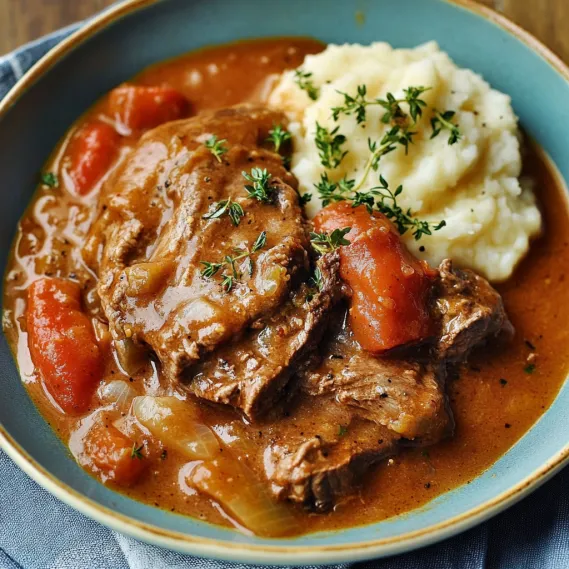 Pin it
Pin it
This old-fashioned Swiss Steak turns tough beef cuts into super soft meat swimming in a thick tomato gravy. Grandma showed me how to make this when I was just starting out in the kitchen, and whenever I smell it cooking now, I'm instantly back at her farm for those big family Sunday meals.
I first cooked this as a newbie wife trying to wow my husband with something fancy that wouldn't break our bank. Now, twenty years down the road, he still asks for it every birthday and we've made it our go-to meal for any big family celebration.
- Bottom Round or Top Round Steak: Look for pieces with less fat and some marbling to get the best texture change while it cooks
- All purpose flour: Helps create that nice outer coating when browning and works to thicken your sauce
- Kosher salt: Brings out all the natural beef flavor – don't be shy with it
- Fire roasted diced tomatoes: That bit of char gives way better flavor than plain diced tomatoes
- Worcestershire sauce: This flavor bomb is why everyone will beg you for your recipe
- Dried marjoram: This underrated herb gives Swiss steak its real, traditional taste
- Low sodium beef broth: Going with low sodium lets you control how salty your dish ends up
- Fresh parsley: Not must-have but adds nice color and freshness to balance the rich flavors
Detailed Cooking Guide
- Soften the Beef:
- Wrap your meat in plastic and beat it with a mallet until it's about half inch thick. This step is super important since it breaks down those tough muscle strands before you even start cooking. Don't rush – work from middle to edges with steady hits. After tenderizing, cut it into serving-sized chunks.
- Coat with Flour Mix:
- Mix flour, salt and pepper in a flat dish. Sprinkle both sides of your beef pieces with extra salt and pepper, then roll them in the flour mix so they're totally covered but not caked. This coating does two jobs – it makes a nice crust and helps your gravy get thick.
- Get a Nice Sear:
- Heat oil in your Dutch oven till it's hot, then carefully drop in your floured beef pieces with space between them. Let them get really golden brown, about 4 minutes each side before flipping. Don't crowd the pan or they'll steam instead of sear. Set them aside when done.
- Build Your Flavor Base:
- Turn heat down to medium and toss in onions and carrots, scraping up all those tasty browned bits from the bottom. Cook until the veggies get soft, around 6 minutes, then throw in garlic just for 30 seconds until you can smell it. Mix in tomato paste and cook for 2 minutes until it gets a bit darker, which brings out its sweetness.
- Create Your Sauce:
- Pour beef broth in while stirring hard to get any stuck bits off the bottom. Add tomatoes, Worcestershire and herbs, mixing everything together. Put the seared beef back in, tucking the pieces into the liquid so they're mostly but not completely covered.
- Let It Cook Slowly:
- Bring everything to a light simmer, put the lid on tight and stick it in your hot oven. Let it cook without peeking for about 1 hour and 45 minutes. The steady oven heat works magic on tough meat, making it super tender while your sauce gets richer and thicker.
- Finishing Touches:
- Take it out of the oven, carefully lift the lid away from your face to avoid steam burns, and check if the meat's tender. You should be able to cut it easily with a fork. Taste your sauce and add more salt, pepper or Worcestershire if needed. Let it sit for 10 minutes before serving it over whatever base you've chosen.
 Pin it
Pin it
Grandma always used her cast iron Dutch oven and swore it put extra iron in our food. Maybe that's true, maybe not, but cooking with her handed-down pot definitely makes the meal feel more special. Sometimes I catch myself chatting with her while I'm stirring, keeping our kitchen talks going even though she's been gone for years now.
Saving and Warming Up
Swiss steak gets better with time, so it's great for planning ahead. Pop leftovers in a sealed container in the fridge for up to 4 days. Don't worry if the sauce gets super thick when cold – that's normal. When you want to eat it again, add a little beef broth to thin the sauce and warm it slowly on the stove over medium-low heat until hot all the way through. Skip the microwave since it can make your meat chewy.
Tasty Serving Ideas
While most folks serve Swiss steak over mashed potatoes, it works great with other bases too. Smooth, creamy polenta soaks up all that yummy gravy but keeps its own texture. Buttered egg noodles give you a lighter option that still catches all the sauce. For a full meal, add a simple green salad with vinaigrette dressing – the tangy flavor balances out the rich main dish perfectly.
 Pin it
Pin it
Cook Now, Enjoy Later
This Swiss steak works wonders as a prep-ahead meal. You can cook it up to two days before you plan to eat it – just cool it completely after cooking and stick the whole Dutch oven in the fridge. When you're ready to eat, take it out about 30 minutes before heating, then warm it in a 325°F oven for about 25 minutes until hot. The flavors will have blended even better, and you won't have any cooking stress when company comes over.
Fixing Chewy Meat
If your meat isn't fork-tender after the cooking time, don't stress. Different meat cuts can vary a lot. Just keep cooking and check every 20 minutes until it feels right. You'll know it's done when you can easily cut it using the side of your fork. If you've got an extra tough cut, try adding another 1/4 cup of liquid and cooking it up to an hour longer.
Frequently Asked Questions
- → Why's it called Swiss steak if it's not from Switzerland?
- It’s got nothing to do with Switzerland! ‘Swiss’ refers to a tenderizing method called ‘swissing,’ where meat is pounded or flattened for cooking.
- → Which steak cut works best for this dish?
- Bottom or top round is great. Chuck steak or shoulder are also good. These tougher meats soften beautifully after tenderizing and slow cooking.
- → Can I cook this in a crockpot?
- Definitely. Sear the meat, cook the veggies a bit, then toss everything in the slow cooker. Let it go for 4-5 hours on high or 7-8 on low.
- → How do I tell if the meat’s done?
- It’s ready when you can pull it apart easily with a fork. This tender stage usually happens around the 2-hour mark, but tougher pieces might take more time.
- → Can leftover Swiss steak be frozen?
- For sure! Store it in airtight containers for up to 3 months. Let it thaw in the fridge overnight before gently reheating on the stove or in a microwave.
